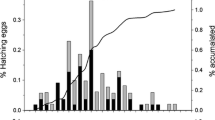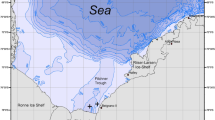Abstract
Japanese cormorants, Phalacrocorax capillatus, are sexually dimorphic seabirds with males that are heavier and that dive deeper than females. Sex differences in prey composition and foraging behavior of those rearing chicks at Teuri Island, Hokkaido, were examined by collecting food-loads from parents in 1992–1998 and by radio-tracking ten birds each in 1997 and 1998 when prey availability was different. Males fed more on benthic and epibenthic fishes (82% mass) than did females (34%) while females fed more on epipelagic and coastal fishes (53%) than did males (18%). Males made longer dives (53 s) at feeding sites closer to the island (7 km) than females (39 s, 13 km) in 1997. In 1998 when the availability of epipelagic fish seemed to be higher, there were no sex differences in dive duration and distance to the feeding sites (35 s and 9 km for males, 36 s and 10 km for females). This sex difference in foraging behavior with a poor availability of epipelagic fish suggests that high diving ability possibly enables males to feed on demersal fish. Birds specializing in coastal shallow waters around the island made long dives; hence they were probably foraging in bottom layers. Those foraging in deeper shelf waters made short dives and they were thought to forage in surface layers.
Similar content being viewed by others
Author information
Authors and Affiliations
Additional information
Electronic Publication
About this article
Cite this article
Ishikawa, K., Watanuki, Y. Sex and individual differences in foraging behavior of Japanese cormorants in years of different prey availability. J Ethol 20, 49–54 (2002). https://doi.org/10.1007/s10164-002-0053-z
Received:
Accepted:
Published:
Issue Date:
DOI: https://doi.org/10.1007/s10164-002-0053-z




